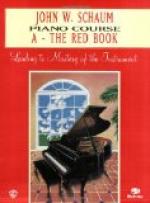“I began my studies in Vienna with Mme. Bree, to get the preparatory foundation, but before long combined her lessons with those of the professor, and later went to him entirely.”
“Just here I should like to mention a trifling point, yet it seems one not understood in America by those who say they are teachers of the Leschetizky method. These teachers claim that the professor wishes the fingers placed on a straight line at the edge of the keys, and in some cases they place the tip of the thumb in the middle of its key, so that it extends considerably beyond the tips of the other fingers. Is this the position taught by the Vorbereiters, or favored by Leschetizky?”
Miss Spencer’s laugh rang out merrily.
“This is the first I have ever heard of the idea! Such a position must seem very strained and unnatural. Leschetizky, on the contrary, wishes everything done in the most easy, natural way. Of course, at first, when one is seeking to acquire strength and firmness of hand and fingers, one must give time and thought to securing an arched hand and steady first joints of fingers. Later, when these conditions have been thoroughly established, the hand can take any position required. Leschetizky’s hand often lies quite flat on the keys. He has a beautiful piano hand; the first joints of the fingers have so long been held firmly curved, that they always keep their position, no matter what he is doing; if he only passes his fingers through his hair, his hand is in shape.
“Leschetizky is indeed a wonderful teacher! The player, however, must divine how to be receptive, how to enter into the master’s thought, or it may go hard with him. If he does not understand, nor grasp the master’s words he may suffer terribly during the ordeal of the lessons. I have witnessed such scenes! Those who are equal to the situation receive most illuminative instruction.
“I trust I do not give you the impression of being so devoted to, and enthusiastic in, the work I enjoyed with my venerated master that I wish to exclude other masters and schools. I think narrowness one of the most unpleasant of traits, and one I should dread to be accused of. I see so much good in others, their ways and ideas, that, to me, all things great and beautiful in art seem very closely related.
MEMORIZING
“How do I memorize a composition? I first play it over a few times to become somewhat familiar with its form and shape. Then I begin to analyze and study it, committing it by phrases, or ideas, one or two measures at a time. I do not always take each hand alone, unless very intricate; sometimes it is easier to learn both hands together. It is a good thing to study out the melodic line, to build each phrase, to work with it till you get it to suit you. Then come the larger proportions, the big climaxes, which have to be thought out and prepared for in advance. A composition should be so thoroughly your own that you can play it at any time, if your hand is in condition. Or, if it has been laid aside for a long time, a couple of days should bring it back.




